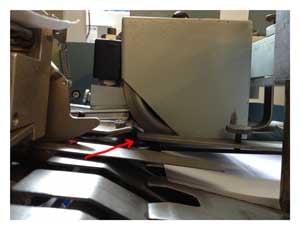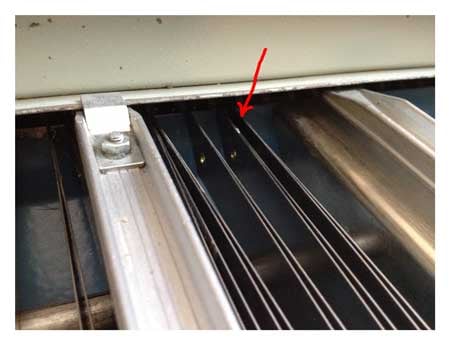How many things can cause paper jams on your folding machine? We can probably come up with dozens of variables. Usually it’s caused by something minor and there are many parts on the folder that  need to be in just the right position to keep the folder operating smoothly. Those little things become hugely important.
need to be in just the right position to keep the folder operating smoothly. Those little things become hugely important.
Whether you’re an experienced folder operator or a novice, check out the list below. The list ranges from the obvious to the unlikely. Yet I know from personal experience they all can cause paper to jam!
Fold Plate is Out of Position
Lower fold plates (#2, 4, 6) are especially prone to slipping out of position and require extra effort to seat correctly. Use a helper if needed.
Feeder is Set Wrong
A paper guide or strap could be in the wrong position and as the paper rounds the feed drum it bends a corner. Or a guide set too snugly could actually be denting the paper. Mechanical fingers and guides  (MBO suction wheel shown at right) can bend or nick the lead edge of the paper which in turn causes a jam. The thinner the paper, the easier it is for this to happen.
(MBO suction wheel shown at right) can bend or nick the lead edge of the paper which in turn causes a jam. The thinner the paper, the easier it is for this to happen.
Bent or Damaged Fold Plate Deflector
A severe paper jam can actually bend a deflector. So if you have a jam and you’ve cleared the machine, yet the problem continues, be sure to check the deflectors. Dings or burrs on a deflector will also interfere with paper travel, especially on lighter weight text stocks.
Static
This is probably one of the most frustrating ones. It can appear out of nowhere. You can read related articles on static and the folding machine here and here.
Curled Paper
Consistent curl is easier to deal with than variable curl. You can usually install paper smoothers, guides, or straps to make the paper go where you want it to go. Or you can manually remove the curl as you load the machine. Sometimes it’s the only thing you can do to get a job to run.
Variable curl, in which the curl varies from sheet to sheet is more difficult. If you don’t want to manipulate the paper, you can always try turning the sheet over so the curl is facing down instead of up (or vice versa) or flip the sheet around so you have a new lead edge.
Paper is Loaded Incorrectly
This is primarily a beginner’s mistake. For maximum bindery equipment production an operator must use care with loading. One sheet loaded wrong, even if it’s only every few thousand sheets, is enough to make a big difference in production.
Missing Waste Strippers or Deflectors
When you have a lot of trimming going on it’s easy to forget one of these as you set up.
Paper Stuck in a Fold Plate
This usually happens when you clean up a previous jam and leave a tiny bit behind. If you just cleared a jam and it happens again when you run the first sheet, be sure to check the area where you just cleaned.
Paper Stuck In or On Fold Rollers
Paper can lodge in the bearings at the edge of the fold rollers. If it vibrates out onto the roller it’s a problem. Sometimes a small piece of paper will actually stick to the surface of the roller, especially if the job isn’t quite dry.
Overlooked Setup Tasks
Say you forgot to move the side lay because the paper only changed size about an inch or less. It’s not obvious that you forgot something. So if you have a jam at the beginning of your setup, re-check your setup tasks first. Remember to use a “flow” technique or a checklist if you are new. After a while you won’t forget anything.
Sheets Stick Together on Press
If you’re loading a continuous feeder in which the paper gets fanned out, you can spot them as you load. If you use your thumb to help fan the sheets you can also feel them. You can read more in this related article on loading continuous feed folding machines.
Paper Has Hidden Bent Corners or Edges
This usually happens in the press delivery. It can also occur coming off the guillotine cutter. As the operator stacks the cut paper on a skid, a corner folds under on the bottom sheet. With experience you get good at spotting these things.
Dirty Fold Rollers
Inks, varnishes, coatings, and toners that haven’t dried or set properly can deposit themselves on the rollers. You might not catch it until it starts to affect the paper.
Worn Fold Rollers
This problem will creep up on you over time. If you’re having problems with folding, including paper jams, it’s time to tune up the machine with some new rollers.
Loose Bolts or Screws
I’ve actually had a small bolt fall onto a passing sheet and cause a jam. Another time some loose bolts on the fold plate bottom pan contributed to jam-ups.
 Tiny Bits of Paper or Dirt in Mysterious Places
Tiny Bits of Paper or Dirt in Mysterious Places
This photo shows an MBO B123 equipped with lattice register tables. Tiny bits of paper like this, or even trapped dust, almost invisible to the naked eye, can nick a sheet and cause a problem.
Folding Machine Accessories
Gluing systems, wet scores, ink jet systems or other tools can cause jams if they malfunction, or if a component is out of adjustment.
Fold Roller Drive Belt
A worn or loose fold roller drive belt can cause folding problems. If it slips momentarily, the gap between the sheet in the fold plate and the next sheet will be reduced, perhaps to a point where it causes a jam. Although this is in the unlikely category, I’ve seen it happen with cover stocks which require a bit more force to fold, especially if the crease or score is weak or out of position.
Please feel free to share your paper-jam story below or add to our list! Or if you have a folding machine problem that stumps you, use the Contact Us to ask your question.


